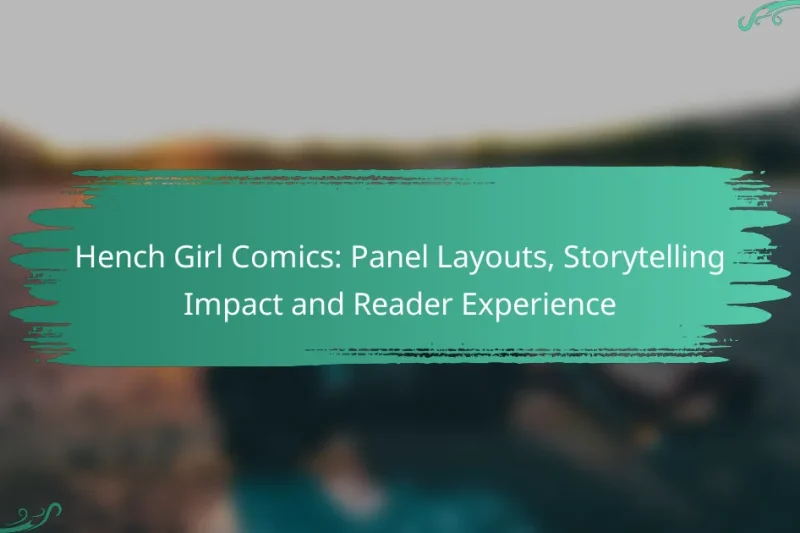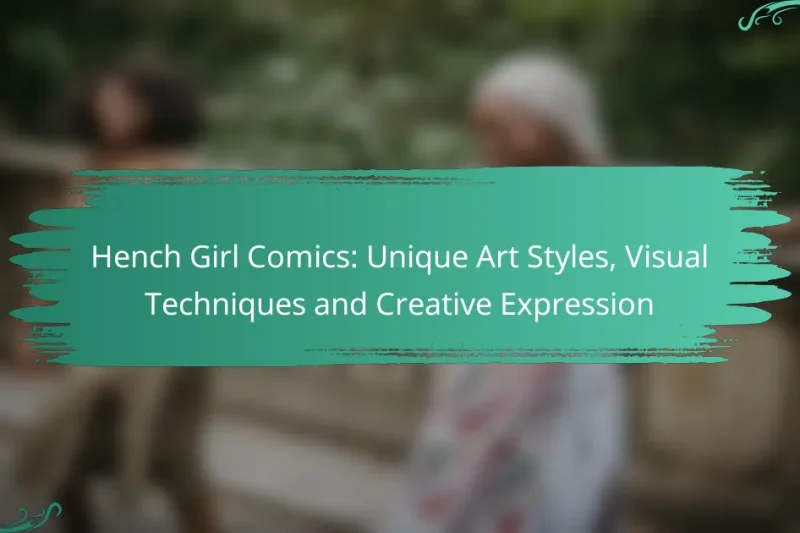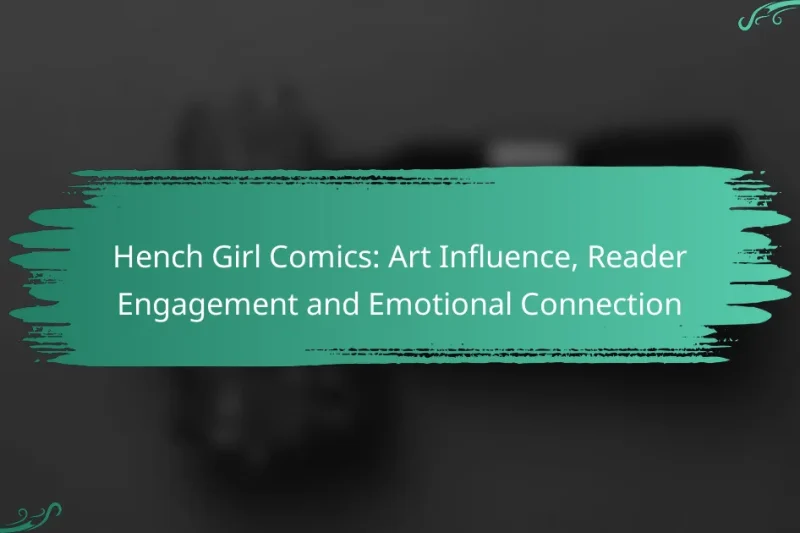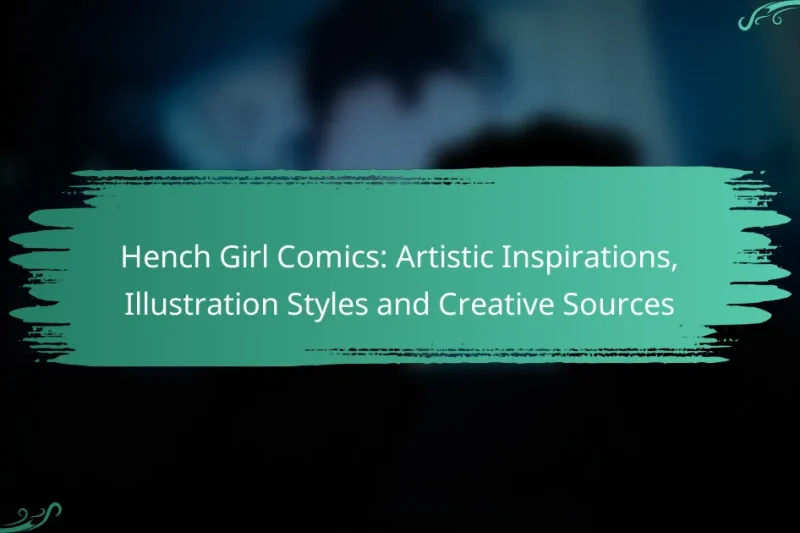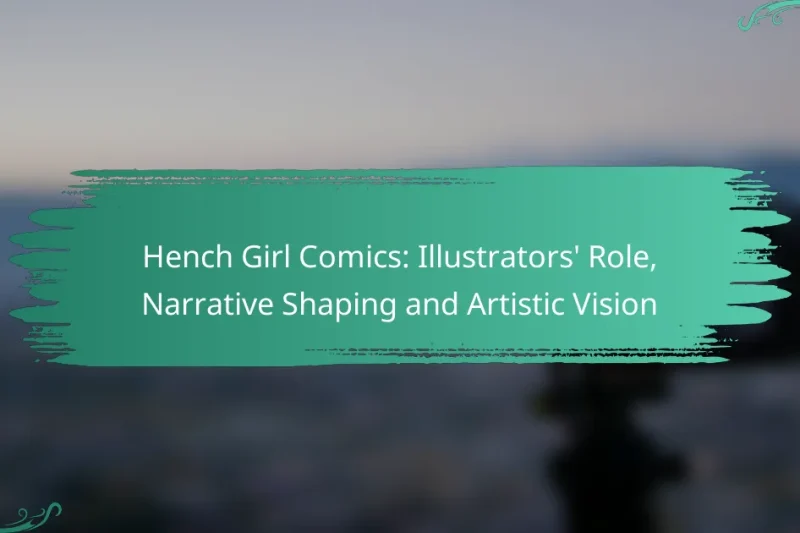In Hench Girl comics, panel layouts play a crucial role in shaping the visual narrative and … Hench Girl Comics: Panel Layouts, Storytelling Impact and Reader ExperienceRead more
Hench Girl Comics: Art Style and Illustration Techniques
Hench Girl comics are characterized by their dynamic action, bold colors, and exaggerated features, which together create an engaging visual experience that captures the energy and humor of the narrative. The illustration techniques employed significantly enhance storytelling, allowing themes and character emotions to resonate deeply with readers. Influenced by pop culture and historical comic art movements, the unique art style of Hench Girl comics enriches the overall storytelling experience.
Hench Girl Comics: Art Techniques, Comparative Analysis and Visual Storytelling
Hench Girl comics utilize innovative art techniques to breathe life into characters and narratives, effectively conveying … Hench Girl Comics: Art Techniques, Comparative Analysis and Visual StorytellingRead more
Hench Girl Comics: Unique Art Styles, Visual Techniques and Creative Expression
Hench Girl Comics are characterized by their unique art styles that distinguish them from traditional comics, … Hench Girl Comics: Unique Art Styles, Visual Techniques and Creative ExpressionRead more
Hench Girl Comics: Art Influence, Reader Engagement and Emotional Connection
Hench Girl Comics play a pivotal role in shaping contemporary art styles by incorporating unique visual … Hench Girl Comics: Art Influence, Reader Engagement and Emotional ConnectionRead more
Hench Girl Comics: Color Schemes, Mood Setting and Visual Impact
In Hench Girl Comics, color schemes are essential for shaping the mood and visual impact of … Hench Girl Comics: Color Schemes, Mood Setting and Visual ImpactRead more
Hench Girl Comics: Artistic Inspirations, Illustration Styles and Creative Sources
The artistic inspirations behind Hench Girl comics are a vibrant fusion of superhero culture, feminist art … Hench Girl Comics: Artistic Inspirations, Illustration Styles and Creative SourcesRead more
Hench Girl Comics: Illustrators’ Role, Narrative Shaping and Artistic Vision
In Hench Girl comics, illustrators play a pivotal role in shaping narratives by visually conveying character … Hench Girl Comics: Illustrators’ Role, Narrative Shaping and Artistic VisionRead more
What are the best art styles in Hench Girl comics?
The best art styles in Hench Girl comics often combine dynamic action, bold colors, and exaggerated features to create an engaging visual experience. These elements work together to convey the energy and humor of the narrative, appealing to a diverse audience.
Dynamic action poses
Dynamic action poses are crucial in Hench Girl comics, as they capture the movement and excitement of the storyline. Artists often use exaggerated angles and perspectives to enhance the sense of motion, making characters appear as if they are leaping off the page.
When creating these poses, consider using a variety of body angles and limb positions to convey energy. For example, a character mid-jump might have arms flailing or legs extended, emphasizing their dynamic action.
Bold color palettes
Bold color palettes are a defining characteristic of Hench Girl comics, often featuring vibrant hues that attract attention. These colors not only enhance the visual appeal but also help to convey the mood and tone of different scenes.
When selecting colors, aim for high contrast to make characters and backgrounds stand out. For instance, pairing bright yellows with deep blues can create a striking effect that draws the reader’s eye.
Exaggerated character features
Exaggerated character features are commonly used in Hench Girl comics to emphasize personality traits and emotions. This can include oversized heads, large eyes, or exaggerated facial expressions that enhance the comedic elements of the story.
To effectively utilize this technique, focus on the traits that define each character. For example, a villain might have sharp, angular features to convey menace, while a hero could have softer, rounder shapes to suggest approachability.
Influence of anime and manga
The influence of anime and manga is evident in the art styles of Hench Girl comics, particularly in character design and action sequences. Many artists draw inspiration from the exaggerated expressions and dynamic movement found in these genres.
Incorporating elements like speed lines or dramatic facial reactions can enhance the storytelling. For example, using motion lines behind a character can visually represent their speed or intensity during a fight scene.
Comic book realism
Comic book realism balances stylization with believable anatomy and environments, providing a grounded feel to the fantastical elements of Hench Girl comics. This approach helps maintain reader engagement by making characters relatable despite their exaggerated features.
To achieve comic book realism, focus on accurate proportions and realistic settings while still allowing for stylistic flair. For instance, a character’s movements should feel plausible, even if their abilities are superhuman.
How do illustration techniques enhance storytelling in Hench Girl comics?
Illustration techniques in Hench Girl comics significantly enhance storytelling by visually conveying themes and character emotions. These methods create a dynamic narrative experience that engages readers and deepens their connection to the story.
Use of visual metaphors
Visual metaphors play a crucial role in Hench Girl comics by representing complex ideas through imagery. For instance, a character surrounded by dark clouds may symbolize inner turmoil or conflict. This technique allows readers to grasp underlying themes without explicit exposition.
When employing visual metaphors, consider their clarity and relevance to the narrative. Ensure that the imagery resonates with the audience’s understanding and enhances the overall message of the comic.
Panel layout and pacing
The layout of panels in Hench Girl comics affects the pacing of the story and influences how readers experience the narrative flow. A grid layout can create a steady rhythm, while irregular panel shapes can evoke tension or surprise. This variation keeps readers engaged and encourages them to linger on significant moments.
To effectively use panel layout, think about the emotional impact you want to create. For fast-paced action scenes, opt for smaller, dynamic panels. For moments of reflection, larger panels can provide space for contemplation.
Character expressions and emotions
Character expressions are vital in Hench Girl comics, as they convey emotions and reactions that drive the story forward. Subtle changes in facial features can indicate a range of feelings, from joy to despair, allowing readers to connect with characters on a deeper level.
When illustrating emotions, focus on exaggeration for clarity. A wide-eyed character can express surprise effectively, while a furrowed brow can indicate concern. Consistency in these expressions helps maintain character identity and enhances the storytelling experience.
What are the key influences on Hench Girl comic art?
The art style of Hench Girl comics is shaped by a blend of pop culture, superhero conventions, and historical comic art movements. These influences create a unique visual narrative that resonates with readers and enhances the storytelling experience.
Pop culture references
Hench Girl comics often incorporate elements from various aspects of pop culture, including movies, television shows, and internet memes. This integration allows the artwork to connect with contemporary audiences, making the characters and scenarios more relatable and engaging.
For instance, visual gags or character designs may echo popular films or viral trends, creating a humorous or satirical effect. This technique not only entertains but also invites readers to reflect on the cultural commentary embedded within the art.
Superhero genre conventions
The superhero genre significantly influences the visual style of Hench Girl comics, with familiar tropes and character archetypes playing a central role. Artists often use bold colors, dynamic poses, and exaggerated features to convey action and emotion, aligning with traditional superhero aesthetics.
Common conventions include the use of capes, masks, and iconic symbols, which help establish character identities quickly. Understanding these conventions allows artists to either embrace or subvert them, adding depth to the narrative and character development.
Historical comic art movements
Historical comic art movements, such as the Golden Age and Silver Age of comics, have laid the groundwork for modern styles seen in Hench Girl comics. These movements introduced various techniques, from line work to panel layouts, that continue to influence contemporary artists.
For example, the use of vibrant colors and dramatic shading techniques can be traced back to these earlier periods. Artists may draw inspiration from specific styles, such as the clean lines of early superhero comics or the more experimental approaches of underground comics, to create a distinctive visual language.
How to choose the right tools for creating Hench Girl comic art?
Selecting the right tools for creating Hench Girl comic art is crucial for achieving the desired style and quality. Consider your preferred medium, whether digital or traditional, as well as the specific techniques you plan to use.
Digital illustration software
Digital illustration software is essential for creating Hench Girl comics with precision and flexibility. Popular options include Adobe Photoshop, Clip Studio Paint, and Procreate, each offering unique features tailored for comic artists. Look for software that supports layers, brushes, and vector graphics to enhance your workflow.
When choosing software, consider your budget and the learning curve associated with each program. Many platforms offer trial versions, allowing you to test their capabilities before committing financially.
Traditional drawing materials
For those who prefer traditional methods, selecting the right drawing materials is key. Quality pencils, inks, and paper can significantly impact your artwork. Brands like Copic for markers and Strathmore for paper are popular among comic artists.
Experiment with different materials to find what suits your style best. For instance, using smooth Bristol board can enhance ink work, while textured paper may benefit pencil sketches. Always keep a variety of tools on hand to adapt to different artistic needs.
Coloring techniques
Coloring techniques play a vital role in bringing Hench Girl comics to life. Whether using digital tools or traditional mediums, understanding color theory and application methods is essential. Techniques such as flat colors, gradients, and shading can add depth and interest to your illustrations.
For digital coloring, explore blending modes and layer effects to create dynamic visuals. In traditional coloring, consider using watercolors or markers for vibrant results. Always test your colors on a separate sheet to ensure they align with your vision before applying them to your final artwork.
What are the common themes in Hench Girl comics?
Hench Girl comics often explore themes of empowerment, identity, friendship, and conflict resolution. These narratives typically focus on the journey of characters as they navigate their roles in a world filled with superheroes and villains.
Empowerment and identity
Empowerment and identity are central themes in Hench Girl comics, where characters often grapple with their self-worth and place in society. The protagonists frequently challenge traditional roles, discovering their strengths and capabilities beyond being sidekicks or henchmen.
For example, a character may start as a low-level henchman but gradually realize their potential as a leader or hero. This transformation highlights the importance of self-discovery and personal growth in the face of adversity.
Friendship and teamwork
Friendship and teamwork play a significant role in Hench Girl comics, showcasing how relationships can empower individuals. Characters often rely on their friends to overcome challenges, emphasizing the value of collaboration and support.
In many stories, the bond between characters is tested, leading to moments of conflict that ultimately strengthen their relationships. This theme reinforces the idea that working together can lead to greater achievements than going solo.
Conflict and resolution
Conflict and resolution are key elements in Hench Girl comics, driving the narrative forward. Characters face various obstacles, whether from rival villains or internal struggles, that require them to confront their fears and make tough choices.
The resolution often involves a blend of clever strategies and personal growth, illustrating how characters can emerge stronger from their experiences. This theme resonates with readers, as it reflects real-life challenges and the importance of resilience.
